Manal AlDowayan reflects on Saudi womanhood at the Venice Biennale
by Cleo Roberts-KomireddiSep 27, 2024
•make your fridays matter with a well-read weekend
by Ayca OkayPublished on : Mar 31, 2024
From Bosco Sodi's gilded volcanic formations to Kader Attia's ethereal Whistleblower sculptures, each installation invites reflection on the profound presence within the absence. Monira Al Qadiri's monumental meteorite works and Kimsooja's iridescent spiral beckon visitors into a realm where time and light intertwine. Giuseppe Penone's majestic bronze tree and Caline Aoun's polished stone reflections unveil the enduring harmony between art and nature. Ibrahim Mahama's terracotta pot expansionist installation hints at the emergence of new ecosystems from the relics of the past. Witness the birth of a cultural landmark as Desert X AlUla paves the way for Wadi AlFann, the Valley of Arts, heralding a new era of monumental land art in 2026.
Renowned for its religious heritage and abundant natural resources, Saudi Arabia is now captivating the world's attention with its cultural investments. It presents itself as a towering figure among various regional competitors. This transformation results from the ambitious Saudi Vision 2030 agenda, which extends beyond the traditional reliance on oil to include investments in multiple sectors. Riyadh, the capital city, has seen significant funding in finance, information technology, tourism, healthcare and education, leading to economic diversification and attracting multinational corporations and skilled professionals to enhance its global stature.
Desert X is part of this cultural drive. Produced by The Desert Biennial, a not-for-profit charitable organisation founded in California, the format primarily focuses on recurring international contemporary art exhibitions in desert locations. These locations are often considered challenging and less productive territories due to their timeless inhabitants and diverse yet limited ecosystems. Similar to the land-art movement of the 1960s in the USA, each edition of Desert X delicately intervenes in the desert landscape, paying great respect to its inherent beauty.
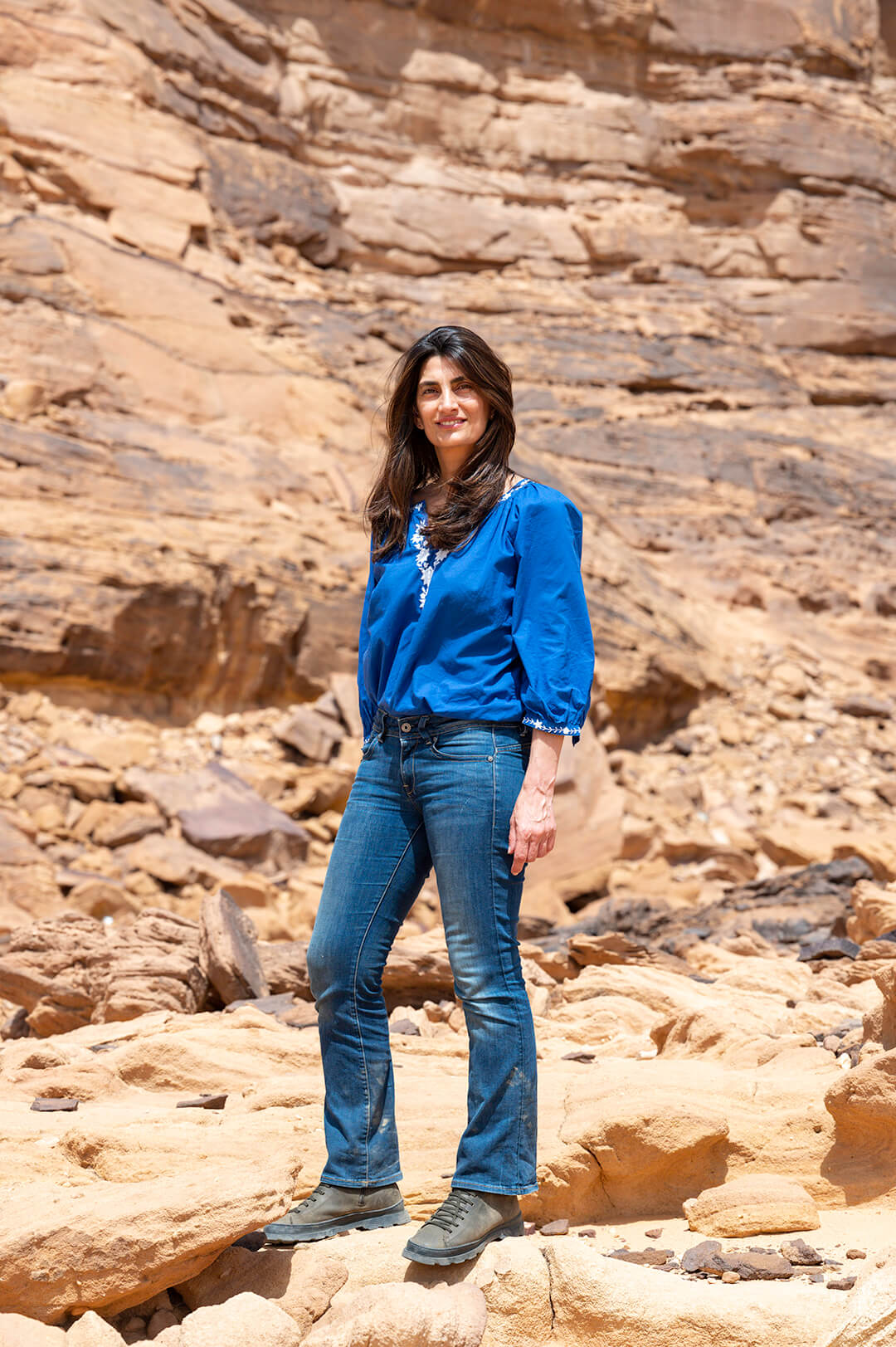
Desert X AlUla, a collaboration between Desert X and the Royal Commission for AlUla, returns for its third edition. It showcases groundbreaking contemporary artworks by Saudi and international artists within the stunning desert landscape of AlUla, a region in northwest Saudi Arabia. AlUla, where the UNESCO World Heritage Site Hegra stands, erected by the Nabataeans over 2,000 years ago, has long been a centre of cultural interchange. Positioned on the ancient incense trade route, it was formerly the capital of the Kingdom of Dadan.
Under the artistic direction of Raneem Farsi and Neville Wakefield, the current rendition of AlUla in Saudi Arabia delves into the theme of In the Presence of Absence. Curated by Maya El Khalil and Marcello Dantas, this iteration of Desert X AlUla seeks to blend the intricate heritage of the region with awe-inspiring landscapes. Khalil, a renowned art advisor and curator specialising in the MENA region joins forces with Dantas, an acclaimed curator known for his innovative interdisciplinary approach, which seamlessly integrates science, history, and technology to craft immersive exhibition experiences.
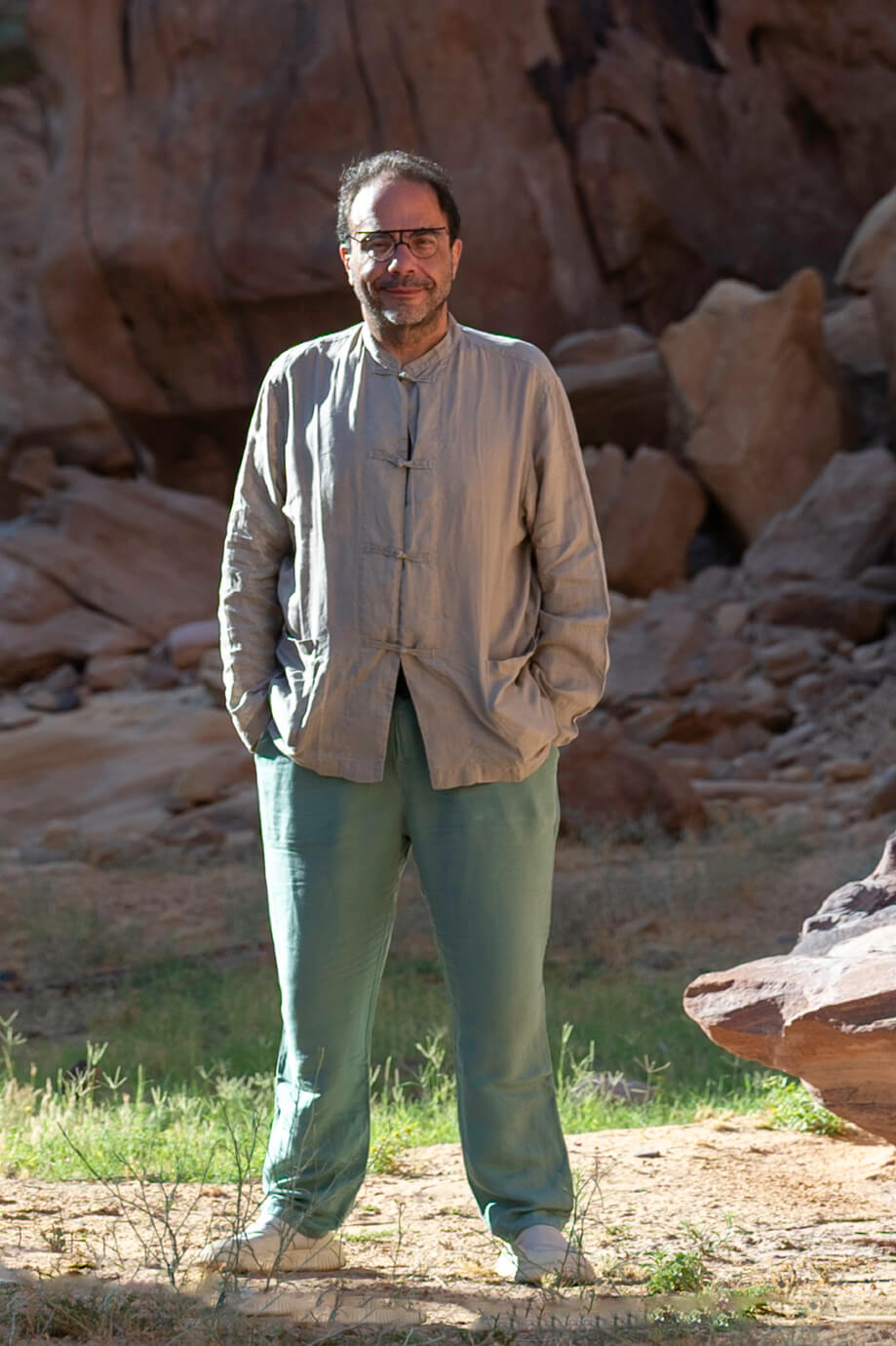
This year's exhibition showcases 15 newly commissioned artworks under the theme In the Presence of Absence. Renowned artists such as Aseel AlYaqoub, Ayman Yossri Daydban, Bosco Sodi, Caline Aoun, Faisal Samra, Filwa Nazer, Giuseppe Penone, Ibrahim Mahama, Kader Attia, Karola Braga, Kimsooja, Monira Al Qadiri, Rana Haddad & Pascal Hachem, Rand Abdul Jabbar, Sara Alissa and Nojoud AlSudairi, and Tino Sehgal are among those featured.
A myriad of artistic expressions converges to redefine our perceptions of emptiness and insignificance within the desert's vast expanse. The participating artists aim to uncover the unseen aspects of the desert landscape, fostering new perspectives on its history and mythology. Sodi has adorned volcanic rocks with gold wrapping, highlighting the inherent beauty of the natural formations. Sometimes, less intervention is the most influential way of creating an impact. Sodi deliberately collaborates with nature and utilises natural rock formations as the centre of his compositions, which have developed over millions of years by respecting the site's integrity. He placed volcanic rocks coated with different sizes of real gold within two opposing rock formations. Assisted by nature, sunlight plays an active role in interacting with these rocks, as the gold glaze absorbs and reflects sunlight at varying angles, adding a dynamic dimension to their relationship.
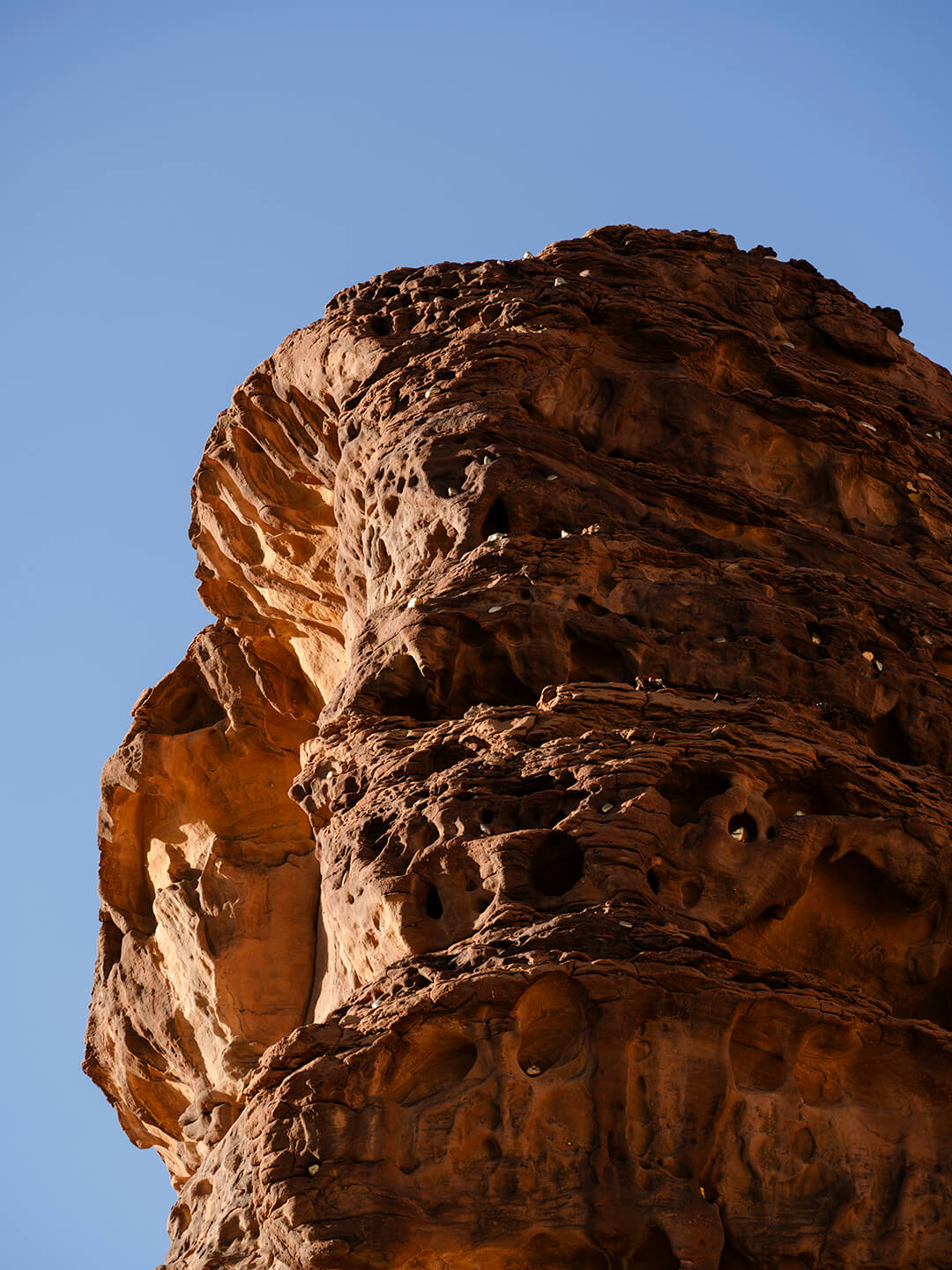
Attia's Whistleblower sculptures (2024) incorporate glass bottlenecks that whistle in the wind, prompting contemplation on environmental concerns. “This immersive and meditative experience provides an intimate dialogue with the desert’s fundamental elements, as the glass was made of sand and air. It creates the meditative space/time for a reflection and connection between human beings and Earth,” Attia states. He adds, “Art can slow time and this is exactly what my intent is here: to slow time for the viewer, to create a moment when their attention is suspended in time and space, outside the constant noise of our civilisations, to come back to something fundamental, elemental, spiritual even.”
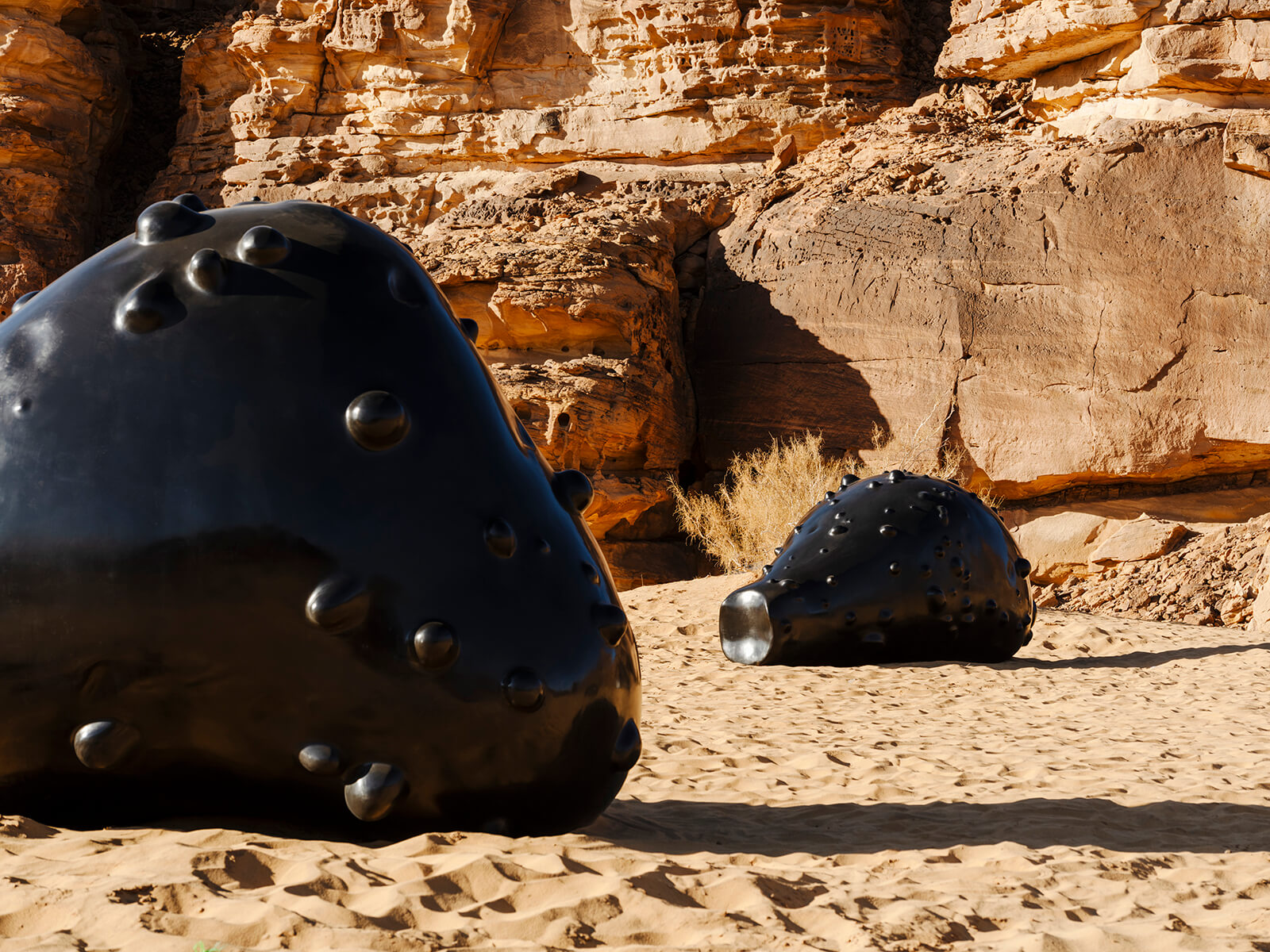
Back to the earth’s scorching hot sands, Qadiri has installed her newly commissioned sculptures, W.A.B.A.R. (2024), with a panoramic view extending in all directions; these enlarged bronze meteorite works resemble the surreal mountainous terrain in the distance. Drawing inspiration from her experiences in the Empty Quarter (The Rub' al Khali desert) which is in the southern third of the Arabian Peninsula, and a tale of British explorer Harry St. John Philby, who traversed the Empty Quarter desert area during the 1930s in search of the remnants of an ancient city and instead stumbled upon what he thought to be the remnants of a volcano. By referring to the accidental discovery of one of the most significant impact craters created by a meteorite, Qadiri’s sculptures in this picturesque desert setting evoke the same sense of astonishment and joy as the historic tale.
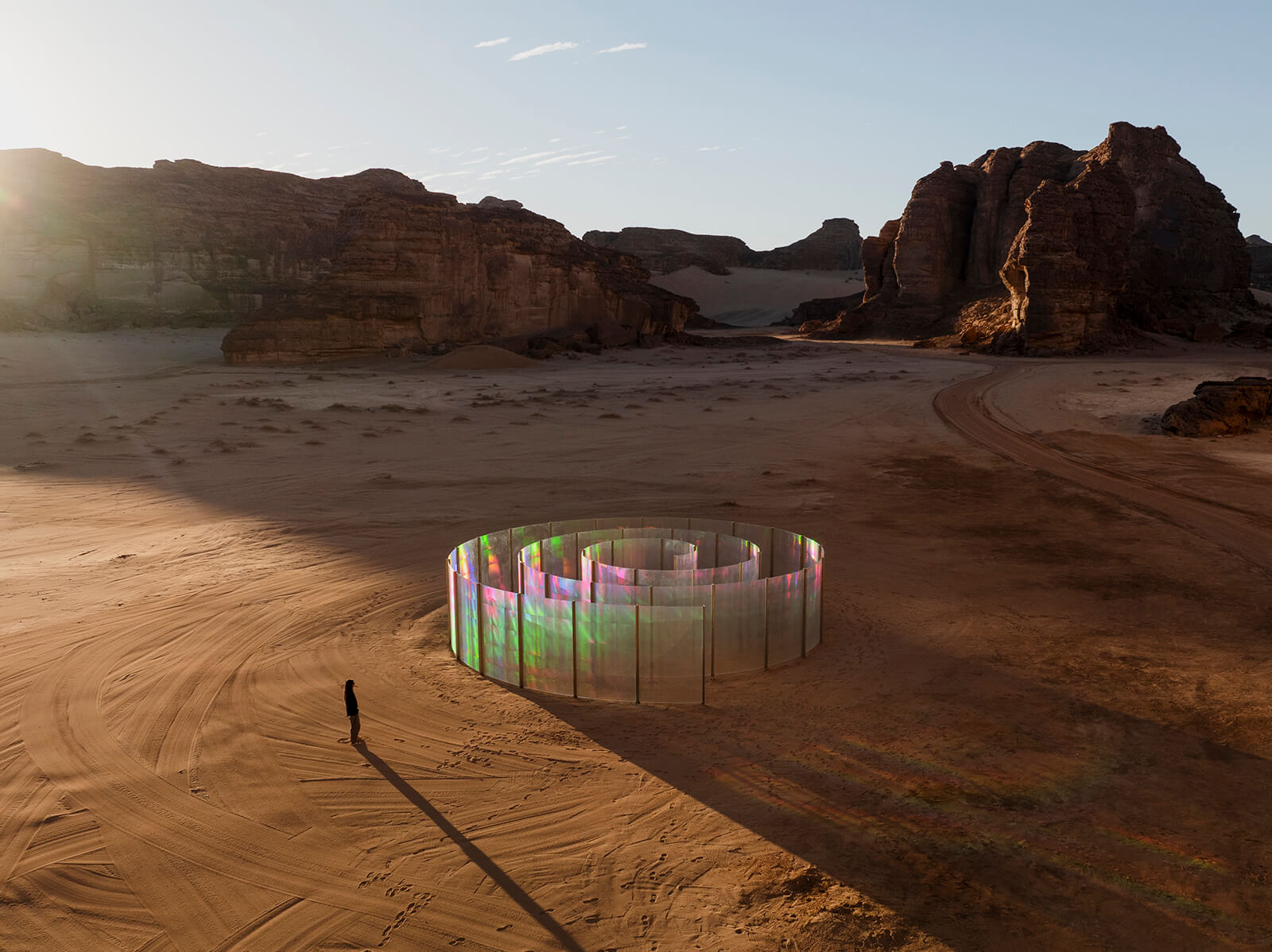
Kimsooja's cylindrical installation draws visitors into a spiral of iridescent walls, capturing light that has traversed aeons. To Breathe – AlUla (2024) captures the wind and the journey of light through a spiral pathway created by a colourful glass surface, which serves as a fluid and translucent medium. Sunlight scatters into a spectrum of iridescent colours, casting rainbow-hued shadows and circular patterns onto the sandy terrain.
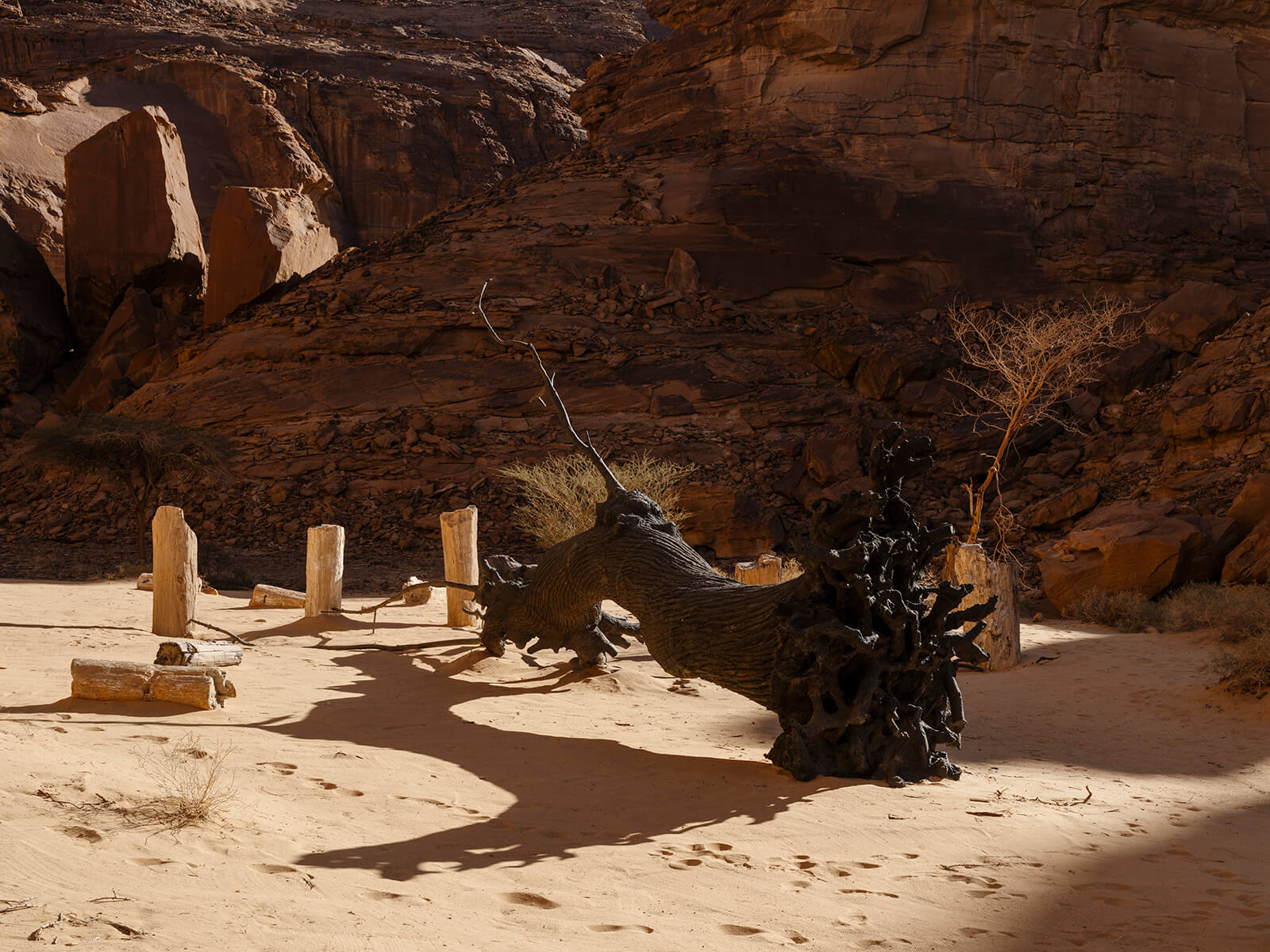
Another otherworldly form is a seven-metre-tall (almost 56-foot-tall) cast bronze chestnut tree produced by Penone. Titled La logica del vegetale—Metamorfosi (Vegetal Logic—Metamorphosis) (2024), it is situated within an ancient desert canyon lying horizontally, with its twisted roots visible, encircled by fragments of fossilised trees. It unveils the interconnectedness of sculpture and the natural world throughout geological epochs. Aoun's installation incorporates polished stones sourced from a basalt plateau, which mirror the transient nature of the desert landscape as it changes under the sun's influence.
Mahama’s installation, Dung Bara – The Rider Does Not Know the Ground Is Hot (2024) is an invader-like expansionist installation. Terracotta pots dispersed throughout the landscape at Dung Bara comprise both newly produced clay pots and those from Ghana, bearing the marks of time as they are old and have been excavated, hinting at the emergence of new ecosystems from remnants of the past, a concept familiar from his practice.
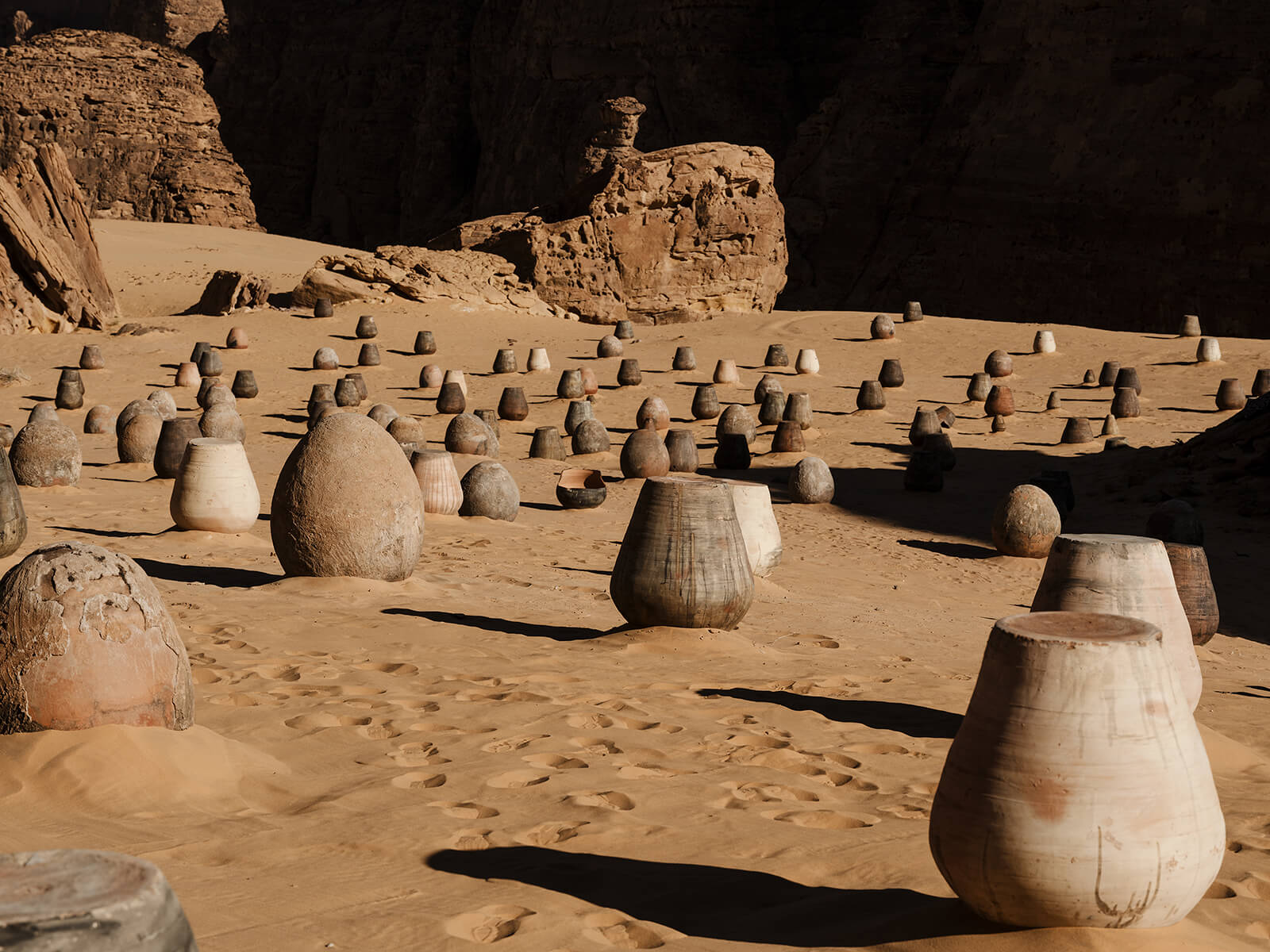
Desert X AlUla continues to appreciate the sacred land of the Arabian soil by establishing another groundbreaking venture to launch in AlUla in 2026: Wadi AlFann, which means “Valley of Arts.” This 65 km site is poised to emerge as a global hub for monumental, site-specific, permanent land art, which is a significant milestone in the Royal Commission for AlUla’s Cultural Manifesto with commissions to be unveiled by Agnes Denes, James Turrell, and Manal Al Dowayan, among others.
by Mrinmayee Bhoot Oct 06, 2025
An exhibition at the Museum of Contemporary Art delves into the clandestine spaces for queer expression around the city of Chicago, revealing the joyful and disruptive nature of occupation.
by Ranjana Dave Oct 03, 2025
Bridging a museum collection and contemporary works, curators Sam Bardaouil and Till Fellrath treat ‘yearning’ as a continuum in their plans for the 2025 Taipei Biennial.
by Srishti Ojha Sep 30, 2025
Fundación La Nave Salinas in Ibiza celebrates its 10th anniversary with an exhibition of newly commissioned contemporary still-life paintings by American artist, Pedro Pedro.
by Deeksha Nath Sep 29, 2025
An exhibition at the Barbican Centre places the 20th century Swiss sculptor in dialogue with the British-Palestinian artist, exploring how displacement, surveillance and violence shape bodies and spaces.
 surprise me!
surprise me!
make your fridays matter
SUBSCRIBEEnter your details to sign in
Don’t have an account?
Sign upOr you can sign in with
a single account for all
STIR platforms
All your bookmarks will be available across all your devices.
Stay STIRred
Already have an account?
Sign inOr you can sign up with
Tap on things that interests you.
Select the Conversation Category you would like to watch
Please enter your details and click submit.
Enter the 6-digit code sent at
Verification link sent to check your inbox or spam folder to complete sign up process



by Ayca Okay | Published on : Mar 31, 2024
What do you think?